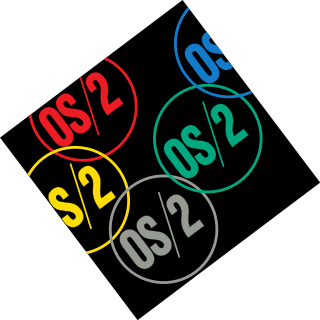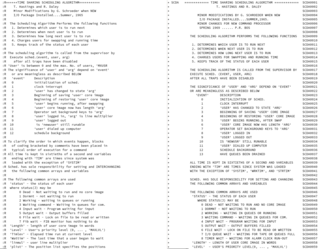Related Research Articles

In computing, BIOS is firmware used to provide runtime services for operating systems and programs and to perform hardware initialization during the booting process. The firmware comes pre-installed on the computer's motherboard.

A computer worm is a standalone malware computer program that replicates itself in order to spread to other computers. It often uses a computer network to spread itself, relying on security failures on the target computer to access it. It will use this machine as a host to scan and infect other computers. When these new worm-invaded computers are controlled, the worm will continue to scan and infect other computers using these computers as hosts, and this behaviour will continue. Computer worms use recursive methods to copy themselves without host programs and distribute themselves based on exploiting the advantages of exponential growth, thus controlling and infecting more and more computers in a short time. Worms almost always cause at least some harm to the network, even if only by consuming bandwidth, whereas viruses almost always corrupt or modify files on a targeted computer.
Malware is any software intentionally designed to cause disruption to a computer, server, client, or computer network, leak private information, gain unauthorized access to information or systems, deprive access to information, or which unknowingly interferes with the user's computer security and privacy. Researchers tend to classify malware into one or more sub-types.

OS/2 is a proprietary computer operating system for x86 and PowerPC based personal computers. It was created and initially developed jointly by IBM and Microsoft, under the leadership of IBM software designer Ed Iacobucci, intended as a replacement for DOS. The first version was released in 1987. A feud between the two companies beginning in 1990 led to Microsoft’s leaving development solely to IBM, which continued development on its own. OS/2 Warp 4 in 1996 was the last major upgrade, after which IBM slowly halted the product as it failed to compete against Microsoft's Windows; updated versions of OS/2 were released by IBM until 2001.
Spyware is any malware that aims to gather information about a person or organization and send it to another entity in a way that harms the user by violating their privacy, endangering their device's security, or other means. This behavior may be present in other malware and in legitimate software. Websites may engage in spyware behaviors like web tracking. Hardware devices may also be affected.

This timeline of computer viruses and worms presents a chronological timeline of noteworthy computer viruses, computer worms, Trojan horses, similar malware, related research and events.
In computing, polymorphic code is code that uses a polymorphic engine to mutate while keeping the original algorithm intact - that is, the code changes itself every time it runs, but the function of the code stays the same. For example, the simple math expressions 3+1 and 6-2 both achieve the same result, yet run with different machine code in a CPU. This technique is sometimes used by computer viruses, shellcodes and computer worms to hide their presence.

The Compatible Time-Sharing System (CTSS) was the first general purpose time-sharing operating system. Compatible Time Sharing referred to time sharing which was compatible with batch processing; it could offer both time sharing and batch processing concurrently.

Antivirus software, also known as anti-malware, is a computer program used to prevent, detect, and remove malware.
Linux malware includes viruses, Trojans, worms and other types of malware that affect the Linux family of operating systems. Linux, Unix and other Unix-like computer operating systems are generally regarded as very well-protected against, but not immune to, computer viruses.

Scareware is a form of malware which uses social engineering to cause shock, anxiety, or the perception of a threat in order to manipulate users into buying unwanted software. Scareware is part of a class of malicious software that includes rogue security software, ransomware and other scam software that tricks users into believing their computer is infected with a virus, then suggests that they download and pay for fake antivirus software to remove it. Usually the virus is fictional and the software is non-functional or malware itself. According to the Anti-Phishing Working Group, the number of scareware packages in circulation rose from 2,850 to 9,287 in the second half of 2008. In the first half of 2009, the APWG identified a 585% increase in scareware programs.
The Michelangelo virus is a computer virus first discovered on 3 February 1991 in Australia. The virus was designed to infect DOS systems, but did not engage the operating system or make any OS calls. Michelangelo, like all boot sector viruses, operated at the BIOS level. Each year, the virus remained dormant until March 6, the birthday of Renaissance artist Michelangelo. There is no reference to the artist in the virus, and it is doubtful that the virus's developer(s) intended a connection between the virus and the artist. The name was chosen by researchers who noticed the coincidence of the activation date. The actual significance of the date to the author is unknown. Michelangelo is a variant of the already endemic Stoned virus.
Jerusalem is a logic bomb DOS virus first detected at Hebrew University of Jerusalem, in October 1987. On infection, the Jerusalem virus becomes memory resident, and then infects every executable file run, except for COMMAND.COM. COM files grow by 1,813 bytes when infected by Jerusalem and are not re-infected. Executable files grow by 1,808 to 1,823 bytes each time they are infected, and are then re-infected each time the files are loaded until they are too large to load into memory. Some .EXE files are infected but do not grow because several overlays follow the genuine .EXE file in the same file. Sometimes .EXE files are incorrectly infected, causing the program to fail to run as soon as it is executed.

Stoned is a boot sector computer virus created in 1987. It is one of the first viruses and is thought to have been written by a student in Wellington, New Zealand. By 1989 it had spread widely in New Zealand and Australia, and variants became very common worldwide in the early 1990s.

A computer virus is a type of malware that, when executed, replicates itself by modifying other computer programs and inserting its own code into those programs. If this replication succeeds, the affected areas are then said to be "infected" with a computer virus, a metaphor derived from biological viruses.
Koobface is a network worm that attacks Microsoft Windows, Mac OS X, and Linux platforms. This worm originally targeted users of networking websites such as Facebook, Skype, Yahoo Messenger, and email websites such as GMail, Yahoo Mail, and AOL Mail. It also targets other networking websites, such as MySpace, Twitter, and it can infect other devices on the same local network. Technical support scammers also fraudulently claim to their intended victims that they have a Koobface infection on their computer by using fake popups and using built-in Windows programs.

MS-DOS is an operating system for x86-based personal computers mostly developed by Microsoft. Collectively, MS-DOS, its rebranding as IBM PC DOS, and a few operating systems attempting to be compatible with MS-DOS, are sometimes referred to as "DOS". MS-DOS was the main operating system for IBM PC compatibles during the 1980s, from which point it was gradually superseded by operating systems offering a graphical user interface (GUI), in various generations of the graphical Microsoft Windows operating system.

Bernd Fix is a German hacker and computer security expert.
Stuxnet is a malicious computer worm first uncovered in 2010 and thought to have been in development since at least 2005. Stuxnet targets supervisory control and data acquisition (SCADA) systems and is believed to be responsible for causing substantial damage to the nuclear program of Iran. Although neither country has openly admitted responsibility, multiple independent news organizations recognize Stuxnet to be a cyberweapon built jointly by the United States and Israel in a collaborative effort known as Operation Olympic Games. The program, started during the Bush administration, was rapidly expanded within the first months of Barack Obama's presidency.
Duqu is a collection of computer malware discovered on 1 September 2011, thought by Kaspersky Labs to be related to the Stuxnet worm and to have been created by Unit 8200. Duqu has exploited Microsoft Windows's zero-day vulnerability. The Laboratory of Cryptography and System Security of the Budapest University of Technology and Economics in Hungary discovered the threat, analysed the malware, and wrote a 60-page report naming the threat Duqu. Duqu got its name from the prefix "~DQ" it gives to the names of files it creates.
References
- ↑ "Threat Assessment of Malicious Code and Human Threats," Archived 2011-04-23 at the Wayback Machine History of Viruses, National Institute of Standards and Technology, Computer Security Division, internal report.
- ↑ "IBM's PC "Virus Timeline,"". research.ibm.com. Archived from the original on 27 October 2012.IBM research report.
- ↑ McAfee Labs Threat Center Archived 2011-07-28 at the Wayback Machine , Details and results of V2PX virus analysis.
- ↑ "Patricia Hoffman's VSUM Virus Information Summary List," Archived 2011-09-27 at the Wayback Machine V2P6 virus.
- ↑ "1260 (computer virus)," Archived 2021-08-17 at the Wayback Machine article.